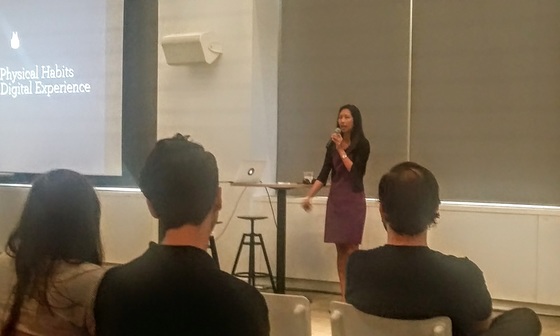How Blue Apron’s Ratings Work to Understand Customers’ Needs
By Dennis Clemente
Blue Apron, Verve Mobile and Imaginary Forces present their design process at Buzzfeed
NEW YORK — Ratings provide us a chance to quickly review a product or service, but Blue Apron found out it’s more than that. Melody Koh said, “People rate (our) recipes because people want us to learn more about them.”
Koh was speaking at the Design Driven meetup last September 13 at the Buzzfeed offices. She was joined by Tom Harman, design manager at Buzzfeed; Walter Geer, creative director at Verve Mobile and Alan Williams, creative director at Imaginary Forces.
If you haven’t heard of Blue Apron, it’s about time you did if you’re interested in learning how to cook. The startup provides all the ingredients you need to make a delicious meal in exactly the right portions.
Blue Apron takes care of the menu planning and shopping (providing you with fresh, locally sourced ingredients in pre-measured quantities), so all you have to do is cook and enjoy. You can choose to skip your orders up to 5 weeks in advance or cancel at any time.
People who don’t know how to cook at all like the idea of having ingredients, as it’s time saved going to the supermarket. Once you get the ingredients, you can watch the video on its site blueapron.com to find how to cook your meal. In terms of portions, it offers a 2-person plan and family plan. You can check out its list of meal choices here https://www.blueapron.com/cookbook
Its 2-Person Plan consists of 3 meals perfectly portioned for 2 people, and is delivered to you once a week. Based on preferences, you’ll receive 3 recipes out of the 6 unique options created by its culinary team each week.The price per serving is $9.99 a meal, or $59.94 for the entire 6-serving delivery. Shipping is always free.
Its Family Plan is for feeding a family of 4 and consists of 4 delicious recipes delivered to your door each week. Depending on the plan, you’ll receive either 2 recipes or all 4 recipes created for that week.
For the week of September 246, here are some meals you should be able to make: Beef & Shishito Open-Faced Sandwiches with tomato, cucumber & Romaine salad; Five-Spice Chicken with Vermicelli, Mushrooms & Baby Fennel; Crispy Catfish with Kale-Faro salad & warm grape relish.
It will also offer Thai Red Curry & Rice with shokichi squash & eggplant; Fontina & Leek Grilled Cheese Sandwicheswith romaine, cucumber & radish salad; Broccoli & Spinach Stromboli with fennel-bell pepper salad & tomato dipping sauce.
Harman talked about design process at BuzzFeed, stressing how important it is to have a unified design process, especially when scaling a business.
“A strong design process establishes a shared vocabulary and offers clear expectations,” he said.
He discussed the five design phases the Buzzfeed design team follows with a chart showing the process and how it unfolds in reality
- Define. Know the problem and uncover as many constraints as possible.
- Explore. Generate as many solutions as possible while exploring the problem space.
- Refine. Validate which solutions work before distilling down the simplest design.
- Build. Translate this through code and design
- Learn. Understand whether the design was successful and whether it needs further work.
Verve Mobile’s Geer thinks that mobile without location is simply display advertising.
Showing how the iPhone can pinpoint your most frequented locations, Geer showed how Verve works to offer only relevant ads.
Founded in 2005, Verve creates mobile ad campaigns for the biggest brands, harnessing the power of location-context mobile data, so the only ads you will see are based on your experiences in your area.
Do you like title designs? The next presenter, Williams certainly does.
If you recall the animated title sequence in Mad Men or the retro design in Netflix’s Stranger Things, the company behind it is Imaginary Forces, a design-based production studio with offices in Hollywood and New York.
Williams showed us how the title design for HBO’s Vinyl came to be. He bought packs of baking powder and used it to create the look for the series’ title design sequence.
“I work using a ‘’method branding approach,” he said, which borrows from the way he actors immerse deep into characters called method acting.
He collects and curates to get the real feel for a project. For Vinyl, it was about “feeling rock and roll.”
Imaginary Forces’ has been doing title designs since 1996 with an impressive roster of clients that include Powerade, Microsoft and Nike.
